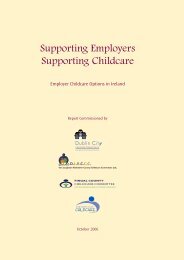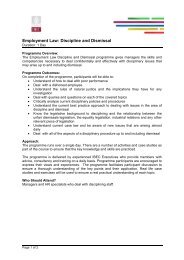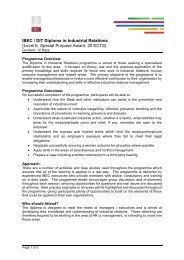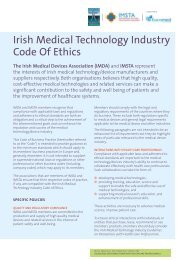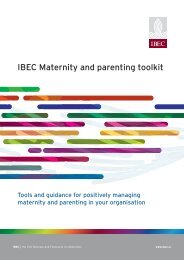Joe Duffy.pdf
Joe Duffy.pdf
Joe Duffy.pdf
Create successful ePaper yourself
Turn your PDF publications into a flip-book with our unique Google optimized e-Paper software.
Breast Cancer Metastasis: Biomarkers and<br />
Functional Mediators<br />
Professor <strong>Joe</strong> <strong>Duffy</strong><br />
St Vincent’s University Hospital,<br />
Dublin and University College Dublin
Introduction to Breast Cancer<br />
• Breast cancer is the most common cancer<br />
affecting women<br />
• World-wide the incidence of breast<br />
cancer is increasing<br />
• Mortality from breast cancer however, is<br />
now declining in several Western<br />
countries
Most Important Questions After a<br />
Diagnosis of Breast Cancer<br />
• How “bad” or aggressive is the tumor<br />
• Will the tumor recur<br />
• Is adjuvant chemotherapy necessary?
Node Negative Breast Cancer<br />
• With screening, 2/3 of newly-diagnosed<br />
breast cancer patients are node-negative<br />
• 70% of node-negative patients cured by<br />
surgery + radiotherapy<br />
• 30% develop recurrent disease by 10 yr<br />
Problem: How to differentiate those with<br />
aggressive from those with indolent ca
Node-Negative Breast Cancer:<br />
Treatment Dilemma<br />
• Circumventing the Dilemma: Treat<br />
almost all node-negative patients with<br />
adjuvant chemotherapy<br />
• Problem: Only a minority of patients will<br />
benefit but most will suffer toxic sideeffects
CHEMOTHERAPY FOR BREAST CANCER:<br />
OVERVIEW OF RANDOMISED TRIALS<br />
• 18,000 women<br />
• 47 trials of chemotherapy vs no chemo<br />
Change in 10-yr survival (node-negative<br />
patients)<br />
•
ADJUVANT CHEMOTHERAPY FOR BREAST<br />
CANCER: OVERVIEW OF RANDOMISED<br />
TRIALS<br />
• 145,000 women<br />
• 194 trials of chemotherapy vs no chemo<br />
Absolute Improvement in Mortality (%)<br />
5 yr 10 yr 15 yr<br />
Women
Side Effects of Chemotherapy<br />
(CMF)<br />
Side effect<br />
% affected<br />
• Nausea 43<br />
• Vomiting 42<br />
• Alopecia 40<br />
• Ovarian failure 70<br />
• Weight gain 12<br />
• Diarrhea 4.5<br />
Shapiro & Recht, N Eng J Med 2001;344:1997
QUESTION<br />
Should most node-negative breast<br />
cancer patients be treated with<br />
chemotherapy so that a small<br />
minority benefit while a large<br />
proportion suffer from adverse<br />
toxic effects ?
Rational Way Forward<br />
Develop and validate markers that will<br />
reliably differentiate between patients<br />
with aggressive and indolent disease<br />
Metastasis is main causes of mortality in<br />
cancer. Since uPA is causally involved in<br />
metastasis, it should be a strong marker<br />
of metastatic potential and thus of<br />
prognosis
Invasion & Metastasis<br />
Invasive<br />
Carcinoma<br />
Normal Epithelium<br />
Stromal cells<br />
& Matrix<br />
1<br />
2<br />
2<br />
Distant Site<br />
Blood Vessel<br />
3<br />
4<br />
PROTEASES<br />
ADHESION MOLECULES<br />
ANGIOGENIC FACTORS<br />
MOTILITY FACTORS<br />
Metastatic<br />
Lesion<br />
5
uPA<br />
• A protease<br />
• It degrades barriers that normally<br />
prevent spread of cancer and opens<br />
up a pathway by which cancer cells<br />
can travel around the body<br />
• Present at higher levels in most<br />
cancers
uPA in Breast Cancer<br />
• We showed that breast cancer patients<br />
with high levels of uPA in their tumor<br />
developed metastasis and died earlier<br />
that patients with low levels<br />
• We showed that uPA was a stronger<br />
predictor of metastasis and early death<br />
than any previously described factor
uPA in Breast Cancer<br />
• We showed that uPA predicted the<br />
formation of metastasis and early death<br />
in patients with lymph node-negative<br />
disease<br />
• We confirmed our findings in an<br />
independent population of patients
uPA as Prognostic Markers in Breast<br />
Cancer<br />
• Prognostic impact of both confirmed by ><br />
20 independent groups<br />
• Prognostic value independent of<br />
traditional factors<br />
• Prognostic value stronger than HER2,<br />
EGFR, CB, CD, p53<br />
• Prognostic in patients with both N+ and<br />
N- disease
uPA: Transfer to Clinic<br />
• Clinical value must be validated in a<br />
gold-standard or level I evidence<br />
study
LOE for Grading Clinical utility<br />
of Tumor Markers<br />
• I. High powered randomized prospective<br />
trial or meta/pooled analysis<br />
• II. Therapeutic trial to test therapeutic<br />
hypothesis but not marker utility<br />
• III. Large retrospective study<br />
• IV. Small retrospective study<br />
• V. Pilot study<br />
Hayes et al JNCI 1996;88:1456
Pooled Analysis of uPA: EORTC<br />
Study<br />
• Raw data: 18 data sets, 8377 patients<br />
• Published, 11; unpublished 7<br />
• Median follow-up: 79 months<br />
• 35% of patients relapsed<br />
• 27% had died<br />
Look et al. JNCI 2002;94:116
Participating laboratories<br />
(9 countries)
Pooled Analysis: Summary<br />
• uPA was an independent prognostic<br />
factors<br />
• uPA ranked second to nodal status but<br />
stronger than size, grade, HR, age<br />
• uPA prognostic in N- and N+ patients<br />
• uPA prognostic in untreated N- patients<br />
Look et al. JNCI 2002;94:116
STRATIFICATION<br />
RANDOMISATION<br />
Prospective Randomized German Multicenter<br />
Therapy Trial in Node-negative Breast Cancer<br />
uPA and PAI-1 low<br />
Observation<br />
Node-negative<br />
Breast Cancer<br />
T > 1 cm and < 5 cm<br />
10 LN analyzed<br />
pre- / postmenopausal<br />
uPA and / or PAI-1 high<br />
Adjuvant<br />
Chemo<br />
(6 x CMF)<br />
Observation
uPA: Prognostic Value in<br />
Breast Cancer<br />
Prognostic value for N- patients confirmed<br />
in 2 different LOE1 studies<br />
• Randomised prospective trial (556)<br />
• Pooled analysis (n=8377)<br />
Janicke et al. JNCI 2001;93:913<br />
Look et al JNCI 2002;94:116
uPA in Breast Cancer:<br />
Implication of Findings<br />
• Patients with low levels of uPA in their breast<br />
cancer have a low probability of developing<br />
metastatic disease.<br />
• These patients may thus be able to avoid the<br />
side effects and costs of chemotherapy.<br />
• This in turn should result in better quality of<br />
life and decreased cost of care
uPA: ASCO Recommendation for<br />
Clinical Use<br />
• uPA may be used for the determination of<br />
prognosis in patients with newly diagnosed,<br />
node negative breast cancer. Low levels are<br />
associated with a sufficiently low risk of<br />
recurrence, especially in hormone receptor–<br />
positive women who will receive adjuvant<br />
endocrine therapy, that chemotherapy will only<br />
contribute minimal additional benefit.<br />
Harris et al. J Clin Oncol 2007;25:5287
uPA for Determining Prognosis in Breast<br />
Cancer: NACB Recommendation<br />
The NACB Panel states that testing for<br />
uPA may be carried out to identify lymph<br />
node-negative patients that do not need<br />
or are unlikely to benefit from adjuvant<br />
chemotherapy.<br />
Sturgeon et al, Clin Chem 2008;54:e11-e79
uPA for Determining Prognosis in Breast<br />
Cancer: NACB Recommendation<br />
Lymph node-negative patients with low levels of<br />
both uPA have a low risk of disease relapse and<br />
thus may be spared from the toxic side effects<br />
and costs of adjuvant chemotherapy. Lymph<br />
node-negative women with high levels of uPA<br />
should be treated with adjuvant chemotherapy.<br />
Sturgeon et al, Clin Chem 2008;54:e11-e79
Acknowledgements<br />
• HRB<br />
• Irish Cancer Society<br />
• European Union<br />
All the researchers, surgeons, medical<br />
oncologists, histopathologists and patients<br />
who helped with this work



